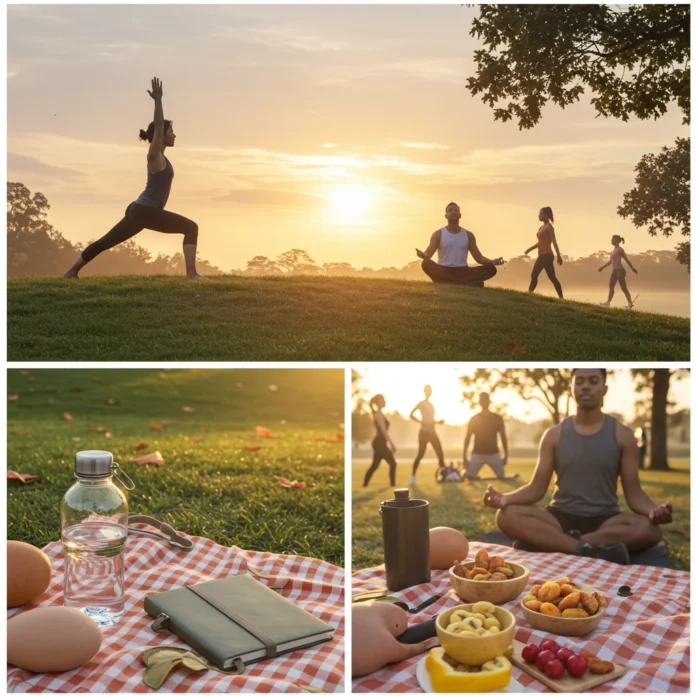Introduction: The Power of Mindfulness in Health & Fitness
Imagine feeling fully present during your workouts, meals, and daily routines. That is the heart of mindfulness, a practice that can transform your approach to health and fitness. Instead of rushing through exercise or eating on autopilot, mindfulness encourages you to tune in to the moment, unlocking greater enjoyment and results.
Whether you are looking to improve physical performance, manage stress, or simply feel better in your body, mindfulness offers practical tools. Let us look at how this simple yet powerful approach can supercharge your health and fitness journey.
What Is Mindfulness? A Simple Explanation
At its core, mindfulness means paying attention to your present experience with openness and curiosity. It is about noticing your thoughts, feelings, and sensations without harsh judgment or distraction.
This state of attentive awareness can be applied to any part of life, from breathing and eating to exercising and relaxing. Mindfulness is not about clearing your mind, but rather about observing what is happening right now, just as it is.
How Does Mindfulness Impact Health and Fitness?
Practicing mindfulness can have a ripple effect on your overall health and fitness. When you are fully present, you make better choices, respond more skillfully to challenges, and notice early signals from your body.
For example, mindful exercisers often notice improved coordination and reduced injury. Mindful eaters tend to have healthier relationships with food. The benefits reach far beyond the gym or dinner table.
The Science Behind Mindfulness: What Research Says
Scientific studies continue to reveal the impressive effects of mindfulness on both physical and mental health. Research shows that regular mindfulness practice can lower blood pressure, boost immune function, and reduce chronic pain.
On the mental health front, findings indicate significant reductions in anxiety, depression, and stress. These outcomes are not just anecdotal — they are supported by brain imaging and clinical trials, making mindfulness a well-established tool for well-being.
Why Is Mindfulness Important for Your Fitness Journey?
Staying committed to fitness goals can be tough. Mindfulness helps you tune in to your body’s needs, recognize unhelpful patterns, and stay motivated even when progress feels slow.
By fostering self-awareness, mindfulness encourages you to celebrate small wins and adjust your approach as needed. This makes it easier to stick with healthy habits over the long haul.
Benefits of Mindfulness for Physical Health
Mindfulness offers a wide range of physical health benefits. It supports better posture, improves movement efficiency, and can even speed up recovery from workouts.
- Reduced muscle tension and injury risk
- Enhanced body awareness and coordination
- Lower blood pressure and heart rate
These advantages add up to more effective workouts and a healthier lifestyle. For more strategies, you can learn more about maximizing your gym results.
Can Mindfulness Improve Mental Well-being?
Absolutely. Mindfulness helps calm racing thoughts, reduces negative self-talk, and builds resilience against everyday stressors. By focusing on the present, you can break free from anxious loops about the past or future.
This mental clarity can leave you feeling more balanced and capable, both inside and outside the gym. Many people also report greater self-acceptance and emotional stability after adopting mindfulness practices.
How Mindfulness Reduces Stress and Anxiety
Mindfulness interrupts the cycle of stress by bringing attention away from worries and back to the present moment. This shift helps the body relax, lowers cortisol levels, and soothes the nervous system.
By practicing mindful awareness, you can respond more thoughtfully to stressful situations instead of reacting automatically. Over time, this leads to lasting reductions in anxiety and greater peace of mind.
Mindfulness and Emotional Eating: What’s the Connection?
Many people turn to food for comfort during stressful times. Mindfulness provides a pause between feeling an emotion and acting on it, allowing you to make more conscious choices about eating.
By noticing hunger and fullness cues, you are less likely to eat out of habit or emotion. This can help you develop a healthier relationship with food and avoid cycles of guilt or overeating.
How Mindfulness Boosts Motivation and Consistency
Staying motivated is easier when you are connected to your reasons for pursuing health and fitness. Mindfulness helps you notice progress, savor achievements, and overcome setbacks without harsh self-criticism.
Consistency comes from being present with your intentions and adjusting your approach as needed. This mindful attitude keeps you moving forward, even on tough days.
Practical Mindfulness Techniques for Everyday Life
You do not need hours of meditation to benefit from mindfulness. Simple techniques can fit into your daily routine and quickly enhance your well-being.
Let us look at three accessible practices you can try right away.
Mindful Breathing: A Step-by-Step Guide
One of the easiest ways to practice mindfulness is through your breath. Find a quiet spot, sit comfortably, and close your eyes if you like.
- Take a slow, deep breath in through your nose, noticing the sensation of air filling your lungs.
- Exhale gently through your mouth, feeling your body relax.
- Repeat for a few cycles, bringing your attention back to the breath whenever your mind wanders.
This technique can calm the mind in just a few minutes.
Body Scan Meditation: How to Get Started
A body scan is a powerful way to connect with your physical sensations. Lie down or sit comfortably, and bring your focus to the top of your head.
Slowly move your attention down your body, noticing areas of tension or comfort. If your mind drifts, gently return to the present sensation. This practice helps you spot early signs of fatigue or stress, supporting both recovery and performance.
Mindful Walking: Turning Steps into Meditation
Walking can be an opportunity for mindfulness, not just exercise. Pay attention to the feeling of your feet touching the ground, the rhythm of your breath, and the sights and sounds around you.
Let distractions pass by without judgment. Mindful walking can transform a simple stroll into a refreshing mental reset.
Integrating Mindfulness into Your Workout Routine
Bringing mindfulness into exercise can make your workouts more effective and enjoyable. It allows you to focus on technique, prevent injuries, and tune in to your body’s signals.
Let us see how you can apply mindfulness to different types of workouts for maximum benefit.
How to Practice Mindful Strength Training
During strength training, focus on the movement of each muscle and the sensation of lifting. Notice your grip, posture, and breathing with every rep.
By staying present, you can optimize form and avoid pushing past your limits. This approach is key for sustainable progress in the gym.
Mindfulness for Yoga and Pilates
Yoga and Pilates naturally encourage mindfulness by connecting movement with breath. As you flow through poses or exercises, pay attention to how your body feels and moves.
Notice subtle shifts in balance, flexibility, and tension. This mindful awareness deepens the impact of each session and supports mind-body harmony.
Running with Awareness: Mindful Cardio Tips
Running can become a moving meditation when you focus on your breath, stride, and the rhythm of your steps. Notice the wind on your face, the sound of your feet, and the scenery around you.
If your thoughts drift, gently return to the sensations of running. This practice can turn even a short jog into a restorative experience. You can also find tours or book activities that combine fitness and mindfulness for added inspiration.
How to Set Mindful Fitness Goals
Mindfulness is a valuable tool for setting goals that truly support your well-being. Instead of chasing numbers or trends, you can align your fitness journey with your values and needs.
Let us compare traditional goal-setting with a mindful approach and explore how to track your progress effectively.
SMART Goals vs. Mindful Goals: What’s the Difference?
SMART goals are Specific, Measurable, Achievable, Relevant, and Time-bound. While these are helpful, mindful goals also consider how you want to feel and what matters most to you.
For example, a mindful goal might focus on enjoying movement or building confidence, not just hitting a target weight. This shift can make your journey more meaningful and sustainable.
Tracking Progress Mindfully: Tools and Techniques
Tracking your fitness does not have to be rigid. Mindful progress involves noticing how your body feels, celebrating small wins, and adjusting your plan without self-judgment.
Journals, mood trackers, or simple check-ins after workouts can help you stay aware and motivated. If you want to take your fitness tracking to the next level, consider integrating tools from our guide to smart home systems for a holistic approach.
Mindfulness for Injury Prevention and Recovery
Listening to your body is essential for avoiding injury and supporting recovery. Mindfulness helps you notice early warning signs and make adjustments before problems arise.
Let us explore how mindful awareness can support both prevention and healing.
Listening to Your Body: Signs You Shouldn’t Ignore
Ignoring pain or fatigue can set you back. Mindfulness teaches you to recognize subtle cues, such as persistent soreness, sharp pain, or unusual tiredness.
By respecting these signals, you can adjust your routine and seek help when needed, preventing more serious issues down the line.
Mindful Stretching and Recovery Routines
Recovery is just as important as training. Mindful stretching involves focusing on sensations, breathing deeply, and moving slowly through each stretch.
This approach helps release tension, improve flexibility, and promote faster healing, so you can return to your favorite activities feeling refreshed.
Mindfulness in Nutrition and Eating Habits
Mindfulness can transform your relationship with food. By paying attention to taste, hunger, and satisfaction, you can make choices that truly nourish your body.
Let us break down what mindful eating is and how to practice it every day.
What Is Mindful Eating?
Mindful eating means being fully present during meals. You notice the flavors, textures, and aromas of your food, and listen to your body’s hunger and fullness signals.
This practice helps you enjoy meals more and prevent overeating, supporting both physical and mental health.
Tips for Practicing Mindful Eating Daily
Try putting away screens and focusing on your meal. Chew slowly and savor each bite, noticing how your body feels as you eat.
- Begin meals with a few deep breaths
- Pause between bites to check in with hunger
- Notice emotional triggers that influence eating
These simple steps can lead to greater satisfaction and healthier choices. For those interested in aligning their food choices with personal values, our guide to sustainable living offers more insights.
How Mindfulness Curbs Cravings and Overeating
Mindfulness helps you recognize cravings as passing sensations, not commands you must follow. By pausing and observing the urge, you can choose how to respond.
Over time, this practice reduces emotional eating and supports a healthier, more balanced approach to nutrition.
Mindfulness and Sleep: The Missing Link in Fitness
Quality sleep is often overlooked in fitness, yet it is essential for recovery and performance. Mindfulness can make falling and staying asleep much easier.
By calming the mind before bed, you set the stage for deeper, more restorative rest.
How Mindfulness Improves Sleep Quality
Mindful practices help quiet racing thoughts and relax the body, making it easier to drift off. They also reduce nighttime anxiety and stress, which can otherwise disrupt sleep.
Consistent mindfulness before bed leads to better sleep patterns, leaving you refreshed and ready for the day ahead.
Bedtime Mindfulness Practices for Better Rest
Simple routines like deep breathing, gentle body scans, or listening to calming sounds can signal your body that it is time to rest.
These practices do not require much time, but their impact on sleep quality can be profound.
Overcoming Common Challenges to Mindfulness
Starting a mindfulness practice can feel daunting, especially if you struggle with focus or consistency. The good news is, these are common obstacles that can be overcome with patience and the right strategies.
Let us look at practical solutions for staying on track.
What If I Can’t Focus? Tips for Beginners
It is normal for your mind to wander during mindfulness exercises. Instead of getting frustrated, gently return your attention to the present moment each time you notice your thoughts drifting.
Short, frequent sessions often work better than long, infrequent ones. Over time, your ability to focus will naturally improve.
How to Stay Consistent with Mindfulness Practices
Building any new habit takes time. Try setting aside a regular time each day, even if just for a few minutes, to practice mindfulness.
Pair your practice with an existing routine, like morning coffee or evening walks, to make it easier to remember. If you are inspired by the latest trends, our post on fashion essentials shows how consistency can make a difference in any area of life.
Myths and Misconceptions About Mindfulness
Mindfulness is often misunderstood. Some believe it is only for certain people or requires special skills, but the truth is more inclusive and accessible.
Let us address two common myths that might be holding you back.
Is Mindfulness Only for Meditation?
While meditation is a popular way to practice mindfulness, it is not the only one. You can bring mindful awareness to any activity, from eating to exercising or even washing dishes.
The key is to pay attention to the present moment, whatever you are doing.
Does Mindfulness Require Special Training?
Mindfulness does not demand formal training or expensive courses. Anyone can begin with simple practices, guided recordings, or mobile apps.
Over time, you may choose to deepen your knowledge, but the basics are available to everyone.
Real-Life Success Stories: Mindfulness Transformations
Many people have experienced powerful changes through mindfulness. From athletes who improved their focus and performance, to individuals who found freedom from emotional eating, the stories are inspiring.
One runner noticed that mindful breathing helped her set a personal best, while another gym-goer overcame plateaus by paying closer attention to recovery needs. These examples show what is possible when you bring presence to your fitness journey.
Expert Tips: How to Deepen Your Mindfulness Practice
Experts recommend starting small and building gradually. Consistency matters more than intensity, so try to practice a little each day.
- Join a mindfulness group or class for support
- Keep a journal to track insights and progress
- Experiment with different techniques to find what works best
Remember, there is no perfect way to be mindful — the most important step is simply to begin.
Creating a Personalized Mindfulness Plan
Personalization is key to making mindfulness a lasting part of your life. Reflect on your goals, challenges, and preferences to craft a plan that fits you.
Consider combining different techniques, scheduling regular check-ins, and adjusting as your needs evolve. This approach keeps your practice fresh and meaningful.
How to Get Started with Mindfulness Today
If you are new to mindfulness, start with a few minutes of focused breathing or a short body scan. Choose a time and place where you feel comfortable and relaxed.
There is no need for perfection — just a willingness to notice and return to the present moment. With patience, mindfulness will become a natural part of your daily routine.
Recommended Resources: Apps, Books, and Courses
Many resources can support your mindfulness journey. Popular apps like Headspace and Calm offer guided meditations and reminders. Books such as “Wherever You Go, There You Are” by Jon Kabat-Zinn provide practical wisdom.
For those who prefer structured learning, online courses and local workshops are available. Explore different options to find what resonates with you.
Frequently Asked Questions About Mindfulness and Fitness
Is mindfulness difficult to learn? Not at all. Simple practices can be picked up in minutes, and consistency is more important than expertise.
Can I practice mindfulness during any activity? Yes, from exercise to eating or even commuting. The key is to pay attention to what you are experiencing right now.
Will mindfulness replace other wellness strategies? Mindfulness complements, rather than replaces, other health and fitness methods. It can enhance the effectiveness of your current routine.
How to Book on Viator
Ready to add mindful experiences to your travels or fitness adventures? Viator makes it easy to find tours, book activities, and plan your trip with confidence. Simply visit their website, browse options by location or interest, and reserve your spot in just a few clicks.
Viator also offers reviews and flexible booking options, so you can choose experiences that align with your mindfulness goals and schedule.
Conclusion: Embrace Mindfulness for a Healthier, Happier You
Mindfulness is more than a buzzword — it is a practical approach that can transform your health, fitness, and overall well-being. By bringing awareness to your body, mind, and daily choices, you unlock new levels of motivation, resilience, and joy.
Whether you are just starting out or looking to deepen your practice, remember that every mindful moment counts. For more inspiration and expert guidance, visit Izase and take the first step toward a more present and empowered life.
Disclaimer: This information is accurate to the best of our knowledge; however, there may be changes or mistakes. Please verify exact details on the Viator booking page.


